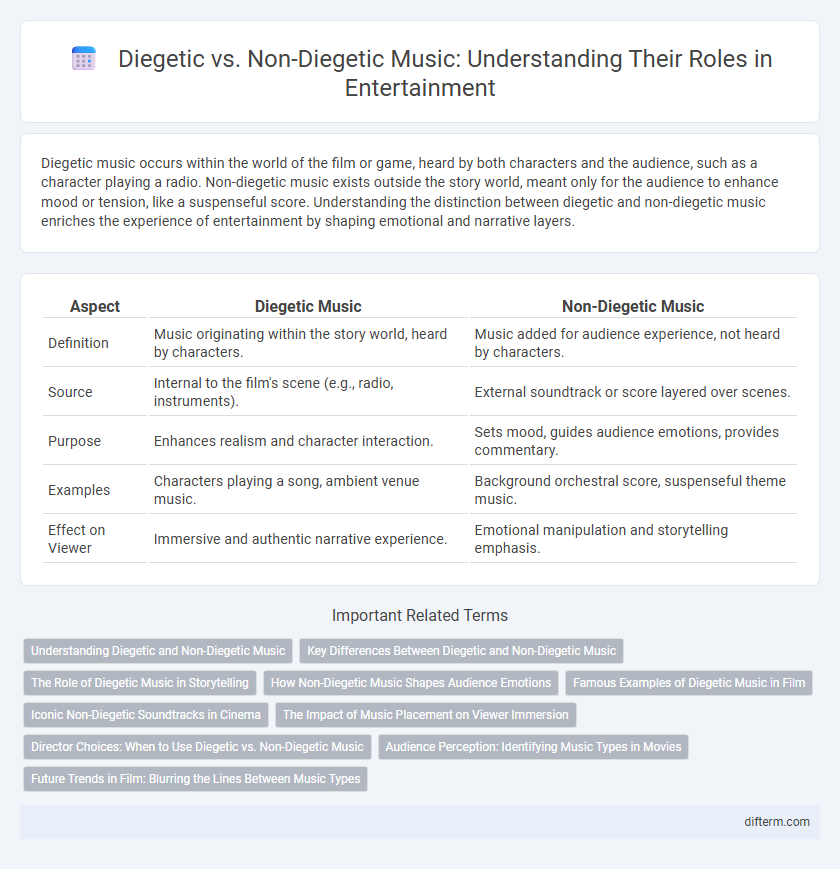Diegetic music occurs within the world of the film or game, heard by both characters and the audience, such as a character playing a radio. Non-diegetic music exists outside the story world, meant only for the audience to enhance mood or tension, like a suspenseful score. Understanding the distinction between diegetic and non-diegetic music enriches the experience of entertainment by shaping emotional and narrative layers.
Table of Comparison
| Aspect | Diegetic Music | Non-Diegetic Music |
|---|---|---|
| Definition | Music originating within the story world, heard by characters. | Music added for audience experience, not heard by characters. |
| Source | Internal to the film's scene (e.g., radio, instruments). | External soundtrack or score layered over scenes. |
| Purpose | Enhances realism and character interaction. | Sets mood, guides audience emotions, provides commentary. |
| Examples | Characters playing a song, ambient venue music. | Background orchestral score, suspenseful theme music. |
| Effect on Viewer | Immersive and authentic narrative experience. | Emotional manipulation and storytelling emphasis. |
Understanding Diegetic and Non-Diegetic Music
Diegetic music originates within the world of the film, heard by characters and integrated into the narrative, such as a song playing on a radio or a live band performing on screen. Non-diegetic music, often called the score, exists outside the characters' environment and is intended only for the audience's emotional and atmospheric experience. Understanding the distinction between diegetic and non-diegetic music enhances appreciation of how filmmakers manipulate sound to influence narrative immersion and emotional impact.
Key Differences Between Diegetic and Non-Diegetic Music
Diegetic music originates within the narrative world, allowing characters and viewers to hear it, such as a radio playing or a band performing on screen. Non-diegetic music exists outside the story, serving as a background score to influence emotions and highlight themes without being heard by characters. The key difference lies in diegetic music's role in the plot and character interaction, while non-diegetic music enhances audience experience through mood and atmosphere.
The Role of Diegetic Music in Storytelling
Diegetic music enhances storytelling by grounding the narrative in a tangible environment where characters interact with the sound, creating an immersive and authentic atmosphere. It reveals character emotions, motivations, and cultural contexts through music that naturally exists within the story world, such as a radio song or a live performance. This integration deepens audience engagement by connecting the sonic experience directly to the plot and setting, unlike non-diegetic music, which operates externally to influence mood and tension.
How Non-Diegetic Music Shapes Audience Emotions
Non-diegetic music, commonly known as the film score or soundtrack, plays a crucial role in shaping audience emotions by providing an emotional undercurrent that complements the visual narrative. By using orchestral arrangements, motifs, and ambient sounds outside the characters' world, directors guide viewers' feelings towards suspense, joy, fear, or sadness, intensifying the cinematic experience. This strategic manipulation of mood through non-diegetic music enhances storytelling impact, deepening audience engagement and emotional resonance.
Famous Examples of Diegetic Music in Film
Famous examples of diegetic music in film include the iconic scene in "Pulp Fiction" where characters dance to Chuck Berry's "You Never Can Tell," integrating the music directly into the narrative world. In "Guardians of the Galaxy," Star-Lord's mixtape serves as a key plot device, with songs playing diegetically through his Walkman and shaping the film's tone. Quentin Tarantino's films frequently feature diegetic music that enhances storytelling by embedding classic tracks within the scene's environment.
Iconic Non-Diegetic Soundtracks in Cinema
Iconic non-diegetic soundtracks in cinema, such as John Williams' score for "Star Wars" and Hans Zimmer's composition for "Inception," play a crucial role in shaping audience emotions and enhancing narrative depth. These soundtracks exist outside the film's world, providing psychological cues and amplifying dramatic tension. Their strategic use often becomes integral to a film's identity, influencing viewer perception beyond the on-screen diegetic sounds.
The Impact of Music Placement on Viewer Immersion
Diegetic music, originating within the narrative world, enhances viewer immersion by grounding scenes in a realistic audio environment that characters can hear, fostering a stronger connection to the story. Non-diegetic music, however, acts as an emotional undercurrent, guiding audience reactions and intensifying dramatic tension without being acknowledged by characters. The strategic placement of diegetic versus non-diegetic music significantly shapes emotional engagement and narrative depth in film and television.
Director Choices: When to Use Diegetic vs. Non-Diegetic Music
Directors strategically choose diegetic music when they want to ground a scene in realism, allowing characters and viewers to share the same auditory experience, such as a radio playing in a car or a live band in a club. Non-diegetic music is employed to evoke emotions, build tension, or foreshadow events, functioning as an external narrative tool that only the audience perceives. Balancing these choices enhances storytelling by blending immersive soundscapes with emotional cues, reinforcing the director's vision and the film's atmosphere.
Audience Perception: Identifying Music Types in Movies
Diegetic music in movies directly originates from the film's world, heard by characters and viewers alike, enhancing realism and immersion. Non-diegetic music functions as a background score, invisible to characters and designed to influence the audience's emotional response and narrative understanding. Understanding these distinctions sharpens audience perception, allowing viewers to engage more deeply with storytelling techniques and emotional cues.
Future Trends in Film: Blurring the Lines Between Music Types
Future trends in film increasingly blur the lines between diegetic and non-diegetic music, integrating soundtracks that dynamically shift from character-aware to external narrative cues. Advanced audio technologies and interactive storytelling techniques enable seamless transitions, enhancing immersive viewer experiences and emotional engagement. This evolution redefines conventional film scoring by merging on-screen performances with ambient soundscapes, creating hybrid sound environments that challenge traditional cinematic boundaries.
diegetic music vs non-diegetic music Infographic

 difterm.com
difterm.com